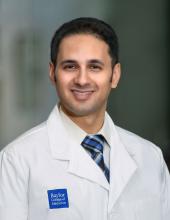shows new research presented in October at the American College of Gastroenterology (ACG) Annual Scientific Meeting.
“We know from previous data that defect closure is beneficial, and reduces complications such as delayed bleeding and delayed perforation,” said Salmaan A. Jawaid, MD, of Baylor College of Medicine, Houston, in a presentation at the meeting.
In the past, defect closure was relatively straightforward; however, “the characteristics of these defects are evolving,” and defects are increasing in size, complexity, and number of locations, he said.
In response, management of resection defects has shifted from a one-step closure to a two-step process with approximation of the widest mucosal edges first, followed by complete resection bed closure, Dr. Jawaid said.
Two novel through the scope (TTS) tissue approximation devices used for the closure of large endoscopic resection defects – the dual-action tissue clip (DAT) and the TTS tack/suture device (TSD) – have not been directly compared on the basis of efficacy and cost, he said.
In the current study, Dr. Jawaid and colleagues randomized 56 adults undergoing tissue approximation and defect closure after endoscopic resection to DAT (31 patients) or TSD (25 patients). The patients were treated at a single center between August 2022 and May 2023 for closures of endoscopic resection defects including gastric, duodenum, and colon lesions greater than 20 mm wide and greater than 30 mm long.
The primary outcomes were technical success of tissue approximation and tissue approximation costs. Secondary outcomes were technical success of complete closure, closure costs, and speed of approximation and closure, as well as safety outcomes. Tissue approximation was defined as less than 15 mm of visible resection bed at the widest margin, and complete closure was defined as no visible resection bed.
Tissue approximation rates were not significantly different between the TSD and DAT groups (88% vs. 83.9%, P = .92). However, approximation cost was significantly lower for DAT compared to TSD ($673.1 vs. $973.6; P = .002).
Similarly, complete closure rates were not significantly different between the TSD and DAT groups (92% vs. 93.5%, P = .83), but closure cost/mm2 was significantly lower for DAT compared to TSD ($1.0/mm2 vs. $1.6/mm2; P = .002).
Notably, the three DAT failures (60%) underwent successful tissue approximation with TSD, and the single TSD failure (33%) underwent successful tissue approximation using DAT.
In terms of speed, the averages for both tissue approximation time and closure speed were significantly faster in the DAT group, compared with the TSD group (12.2 minutes vs. 4 minutes, P < .0001; 72.7 mm2/min vs. 153.5 mm2/min; P = .003).
“The DAT clip was three times faster than the TSD,” Dr. Jawaid said in his presentation. Adverse events including device-related events, post–electrocautery syndrome, and delayed bleeding were similarly low with both devices. However, the DAT can be less effective in some circumstances, such as a closed space or difficult location. In the cases of duodenal defects, TSD was able to approximate all, but DAT was unable to approximate any. Reasons for DAT clip failure in these cases included the resection bed being too large and tissue tearing upon grasping. In the TSD group, the presence of looping was associated with failures for cecum and colon defects.

